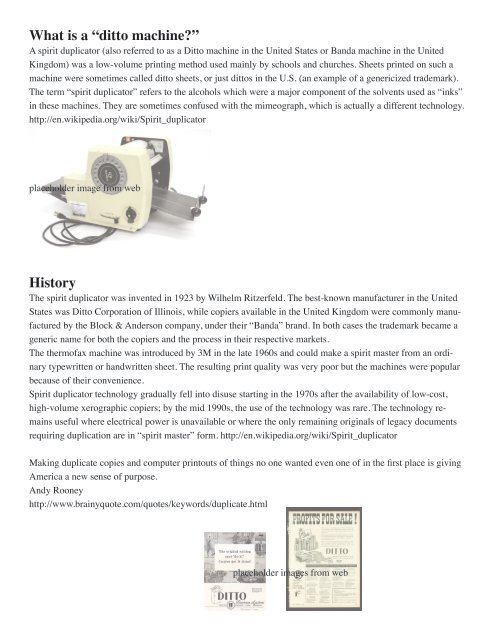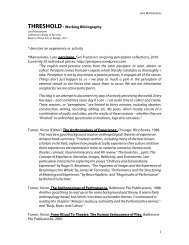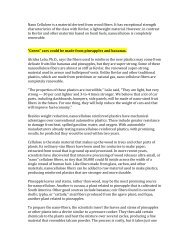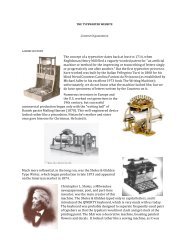What is a “ditto machine?” History
What is a “ditto machine?” History
What is a “ditto machine?” History
Create successful ePaper yourself
Turn your PDF publications into a flip-book with our unique Google optimized e-Paper software.
<strong>What</strong> <strong>is</strong> a <strong>“ditto</strong> <strong>machine</strong>?<strong>”</strong><br />
A spirit duplicator (also referred to as a Ditto <strong>machine</strong> in the United States or Banda <strong>machine</strong> in the United<br />
Kingdom) was a low-volume printing method used mainly by schools and churches. Sheets printed on such a<br />
<strong>machine</strong> were sometimes called ditto sheets, or just dittos in the U.S. (an example of a genericized trademark).<br />
The term “spirit duplicator<strong>”</strong> refers to the alcohols which were a major component of the solvents used as “inks<strong>”</strong><br />
in these <strong>machine</strong>s. They are sometimes confused with the mimeograph, which <strong>is</strong> actually a different technology.<br />
http://en.wikipedia.org/wiki/Spirit_duplicator<br />
placeholder image from web<br />
H<strong>is</strong>tory<br />
The spirit duplicator was invented in 1923 by Wilhelm Ritzerfeld. The best-known manufacturer in the United<br />
States was Ditto Corporation of Illino<strong>is</strong>, while copiers available in the United Kingdom were commonly manufactured<br />
by the Block & Anderson company, under their “Banda<strong>”</strong> brand. In both cases the trademark became a<br />
generic name for both the copiers and the process in their respective markets.<br />
The thermofax <strong>machine</strong> was introduced by 3M in the late 1960s and could make a spirit master from an ordinary<br />
typewritten or handwritten sheet. The resulting print quality was very poor but the <strong>machine</strong>s were popular<br />
because of their convenience.<br />
Spirit duplicator technology gradually fell into d<strong>is</strong>use starting in the 1970s after the availability of low-cost,<br />
high-volume xerographic copiers; by the mid 1990s, the use of the technology was rare. The technology remains<br />
useful where electrical power <strong>is</strong> unavailable or where the only remaining originals of legacy documents<br />
requiring duplication are in “spirit master<strong>”</strong> form. http://en.wikipedia.org/wiki/Spirit_duplicator<br />
Making duplicate copies and computer printouts of things no one wanted even one of in the first place <strong>is</strong> giving<br />
America a new sense of purpose.<br />
Andy Rooney<br />
http://www.brainyquote.com/quotes/keywords/duplicate.html<br />
placeholder images from web
How does it work?<br />
The duplicator used two-ply “spirit masters<strong>”</strong>. The first sheet could be typed, drawn, or written upon. The second<br />
sheet was coated with a layer of wax that had been impregnated with one of a variety of colorants. The pressure<br />
of writing or typing on the top sheet transferred colored wax to its back side, producing a mirror image of<br />
the desired marks. (Th<strong>is</strong> acted like a reverse of carbon paper.) The two sheets were then separated, and the first<br />
sheet was fastened onto the drum of the (manual or electrical) <strong>machine</strong>, with the waxed side out.<br />
There <strong>is</strong> no ink used in spirit duplication. As the paper moves through the printer, the solvent <strong>is</strong> spread across<br />
each sheet by an absorbent wick. When the solvent-impregnated paper comes into contact with the waxed original,<br />
it d<strong>is</strong>solves just enough of the pigmented wax to print the image onto the sheet as it goes under the printing<br />
drum. http://en.wikipedia.org/wiki/Spirit_duplicator<br />
http://vimeo.com/4106454 http://vimeo.com/4120558 placeholder image from web<br />
Purple color<br />
The usual wax color was aniline purple, a cheap, durable pigment that provided good contrast, but masters were<br />
also manufactured in red, green, blue, black, and the hard-to-find orange, yellow, and brown. All except black<br />
reproduced in pastel shades: pink, mint, sky blue, etc. Ditto had the useful ability to print multiple colors in a<br />
single pass, which made it popular with cartoon<strong>is</strong>ts. Multi-colored designs could be made by swapping out the<br />
waxed second sheets; for instance, shading in only the red portion of an illustration while the top sheet was<br />
positioned over a red-waxed second sheet. Th<strong>is</strong> was possible because the pungent-smelling duplicating fluid<br />
(typically a 50/50 mix of <strong>is</strong>opropanol and methanol) was not ink, but a clear solvent. http://en.wikipedia.org/<br />
wiki/Spirit_duplicator<br />
placeholder image from web<br />
http://www.spartantailgate.com/forums/msu-red-cedar-message-board/387238-ditto-<strong>machine</strong>.html<br />
The aroma of pages fresh off the duplicator combined with the cool touch from the evaporating alcohol was<br />
a memorable feature of school life for those who attended in the spirit duplicator era. A pop culture reference
to th<strong>is</strong> <strong>is</strong> to be found in the film Fast Times At Ridgemont High. At one point a teacher hands out a duplicated<br />
exam paper and every student in the class immediately lifts it to h<strong>is</strong> or her nose and inhales. http://en.wikipedia.<br />
org/wiki/Spirit_duplicator<br />
Ridgemont High ditto sniff clip<br />
http://www.youtube.com/watch?v=n9huSs0g67c&p=60619B6910FF298F&playnext=1&index=10<br />
Thoughts on the nature of copies<br />
dit·to noun<br />
1 : a thing mentioned previously or above —used to avoid repeating a word —often symbolized by inverted<br />
commas or apostrophes<br />
2 : a ditto mark<br />
Origin of DITTO<br />
Italian ditto, detto, past participle of dire to say, from Latin dicere — more at diction<br />
First Known Use: circa 1639<br />
http://www.merriam-webster.com/dictionary/ditto<br />
dit·to vt<br />
1 : to repeat the action or statement of<br />
2 [from Ditto, a trademark] : to copy (as printed matter) on a duplicator<br />
Examples of DITTO<br />
<br />
First Known Use of DITTO 1725<br />
http://www.merriam-webster.com/dictionary/ditto<br />
du·pli·cate noun \-kət\<br />
1a : either of two things exactly alike and usually produced at the same time or by the same process<br />
b : an additional copy of something (as a book or stamp) already in a collection<br />
2: one that resembles or corresponds to another : counterpart<br />
3: two identical copies —used in the phrase in duplicate<br />
Examples of DUPLICATE<br />
In case you lose your keys, keep a set of duplicates somewhere safe.<br />
<br />
First Known Use of DUPLICATE 1532<br />
http://www.merriam-webster.com/dictionary/duplicate<br />
copy noun<br />
1 : an imitation, transcript, or reproduction of an original work (as a letter, a painting, a table, or a dress)<br />
2 : one of a series of especially mechanical reproductions of an original impression; also : an individual example<br />
of such a reproduction
3 archaic : something to be imitated : model<br />
4 a : matter to be set especially for printing<br />
b : something considered printable or newsworthy —used without an article <br />
c : text especially of an advert<strong>is</strong>ement<br />
5 : duplicate 1a <br />
Examples of COPY<br />
The novel has sold more than a million copies.<br />
She got a job writing advert<strong>is</strong>ing copy.<br />
All copy must be submitted by 5 p.m.<br />
Origin of COPY<br />
Middle Engl<strong>is</strong>h copie, from Anglo-French, from Medieval Latin copia, from Latin, abundance — more at copious<br />
First Known Use: 14th century<br />
http://www.merriam-webster.com/dictionary/copy<br />
Duplicates, true form<br />
Plato’s Cave<br />
Plato imagines a group of people who have lived chained in a cave all of their lives, facing a blank wall. The<br />
people watch shadows projected on the wall by things passing in front of a fire behind them, and begin to ascribe<br />
forms to these shadows. According to Plato, the shadows are as close as the pr<strong>is</strong>oners get to seeing reality.<br />
He then explains how the philosopher <strong>is</strong> like a pr<strong>is</strong>oner who <strong>is</strong> freed from the cave and comes to understand that<br />
the shadows on the wall are not constitutive of reality at all, as he can perceive the true form of reality rather<br />
than the mere shadows seen by the pr<strong>is</strong>oners. Link to allegory text: http://webspace.ship.edu/cgboer/platoscave.<br />
html<br />
Cave video:<br />
http://www.youtube.com/watch?v=69F7GhASOdM<br />
“I don’t need a friend who changes when I change and who nods when I nod; my shadow does that much better.<strong>”</strong><br />
Plutarch<br />
http://www.quotesdaddy.com/tag/Ditto<br />
Captain Caveman and Son: The Ditto Master<br />
http://www.youtube.com/watch?v=wSDJpmQwDVA
Cloning<br />
A man’s desire for a son <strong>is</strong> usually nothing but the w<strong>is</strong>h to duplicate himself in order that such a remarkable pattern<br />
may not be lost to the world.<br />
Helen Rowland<br />
http://www.brainyquote.com/quotes/keywords/duplicate.html<br />
Success <strong>is</strong> dangerous. One begins to copy oneself, and to copy oneself <strong>is</strong> more dangerous than to copy others. It<br />
leads to sterility.<br />
Pablo Picasso<br />
http://www.brainyquote.com/quotes/keywords/copy_4.html<br />
Cloning in biology <strong>is</strong> the process of producing similar populations of genetically identical individuals that occurs<br />
in nature when organ<strong>is</strong>ms such as bacteria, insects or plants reproduce asexually. Cloning in biotechnology<br />
refers to processes used to create copies of DNA fragments (molecular cloning), cells (cell cloning), or organ<strong>is</strong>ms.<br />
The term also refers to the production of multiple copies of a product such as digital media or software.<br />
The term clone <strong>is</strong> derived from κλῶνος, the Greek word for “trunk, branch<strong>”</strong>, referring to the process whereby a<br />
new plant can be created from a twig. In horticulture, the spelling clon was used until the twentieth century; the<br />
final e came into use to indicate the vowel <strong>is</strong> a “long o<strong>”</strong> instead of a “short o<strong>”</strong>.[1][2] Since the term entered the<br />
popular lexicon in a more general context, the spelling clone has been used exclusively.<br />
http://en.wikipedia.org/wiki/Cloning<br />
Pokemon Ditto<br />
http://bulbapedia.bulbagarden.net/wiki/Ditto_(Pokémon)<br />
Invasion of the Body Snatchers trailer<br />
http://www.youtube.com/watch?v=mTSR6bu0Nq0<br />
Bad art<strong>is</strong>ts copy. Good art<strong>is</strong>ts steal.<br />
Pablo Picasso<br />
http://www.brainyquote.com/quotes/keywords/copy.html<br />
I’m starting to see players copy what I do. I’m flattered.<br />
Denn<strong>is</strong> Rodman<br />
http://www.brainyquote.com/quotes/keywords/copy_2.html
Improv Everywhere: Human Mirror Subway<br />
http://www.youtube.com/watch?v=9MBBr-a2KnM&feature=channel<br />
Ditto testimonials<br />
Kenny Chan said...<br />
Cool, Im really glad someone <strong>is</strong> trying trying to make use of a spirit duplicator still. I’ve loved working with<br />
these <strong>machine</strong>s since helping my teachers ‘run off’ exams on them. Many online articles mention how poor the<br />
quality of the copies could be. MANY people who used them didn’t know how. Usually the more expensive<br />
versions had pressure controls- the bottom rubber wheel would press tighter against the drum (large cylinder)<br />
and the right manipulation/amount of ‘ink’ on the wick would wet the paper enough to get great copies. My<br />
teacher didn’t even care she’d given me the test master to copy for my own class, because I made really clear<br />
prints. Anyway, that was a bit nostalgic. Have fun! lol<br />
AUGUST 9, 2010 10:35 PM<br />
http://peteglover.blogspot.com/2009/07/ditto.html<br />
Demi Moore said:<br />
http://www.youtube.com/watch?v=6qs-SZQ7sSA<br />
The best images arrived when I really soaked the paper in fluid. I made a pretty big mess, wasted a lot of paper,<br />
screamed curses more than once, came out with a few great images (I’ll post them soon) and probably shortened<br />
my life span by a year or two. I probably have just enough newsprint and duplicating fluid for one more try.<br />
Pete Glover<br />
http://peteglover.blogspot.com/2009/07/ditto.html<br />
I love the smell of Ditto in the morning! Smells like... grammar school.<br />
http://theyalwayscomeback.blogspot.com/2008/02/ditto-<strong>machine</strong>.html<br />
In grade school we used to get handouts made with the ditto <strong>machine</strong>. If they were freshly run copies, most of<br />
us kids would gleefully put the sheet to our face and inhale deeply...<br />
http://theyalwayscomeback.blogspot.com/2008/02/ditto-<strong>machine</strong>.html<br />
I recently came across your blog and have been reading along. I thought I would leave my first comment. I don’t<br />
know what to say except that I have enjoyed reading. Nice blog. I will keep v<strong>is</strong>iting th<strong>is</strong> blog very often.<br />
Lucy<br />
http://theyalwayscomeback.blogspot.com/2008/02/ditto-<strong>machine</strong>.html











